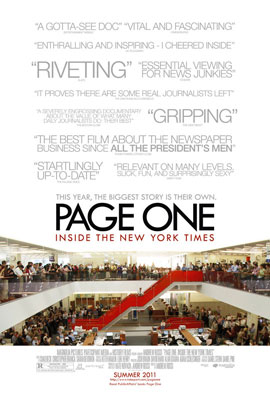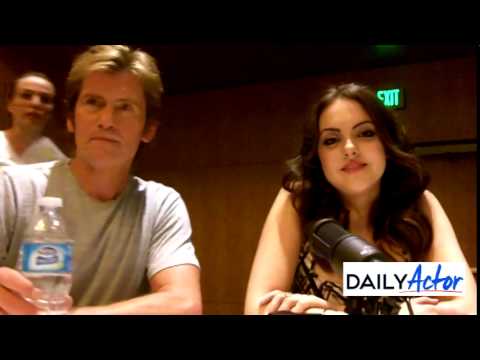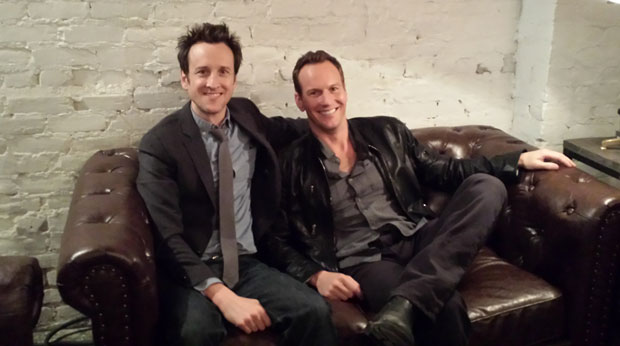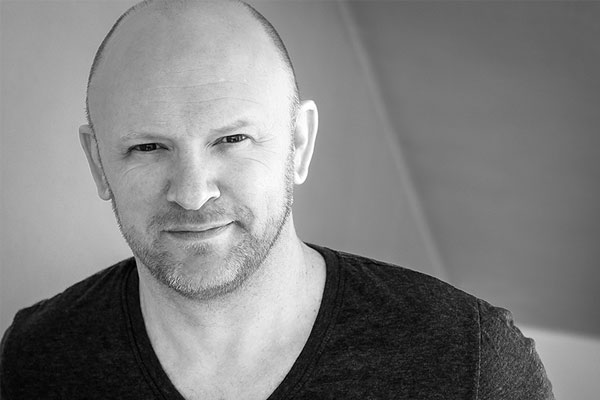If you’re in the mood to see a truly wonderful documentary, look no further than Andrew Rossi’s excellent Page One: Inside the New York Times.
I’ve had a true fascination with the Times for the past several years. Maybe it started when this site became active and I finally appreciated all the work journalists do (and please don’t think I’m calling myself a journalist). Maybe it was because I played a reporter for the Baltimore Sun in an episode of Homicide ages ago. Maybe it was me walking past their building on the way to the Drama Book Shop every time I’m in New York City. Whatever it is, I’m fascinated with them.
Director Rossi followed Times media reporters David Carr and Brian Stelter (among others) for a year, documenting the inner workings of the newsroom; from breaking huge news stories to the decline of the physical paper to the introduction of the controversial pay-wall they now have.
For me, Stelter is the true star of the film. He grew up in the town next to mine in Maryland and we went to the same college (Towson State) and he’s a true multi-tasker in every sense of the word. He works with 2 laptops in front of him; simultaneously surfing the web, talking on the phone and quite possibly, updating his Twitter status.
Watching him work was inspiring to me. And I’m betting it’ll inspire you as well.
I got a chance to chat with Brian on a via online chat where he talked about getting hired by the paper right out of college, the film and yes Twitter.
And if you’re not already following him, now’s your chance: @BrianStelter
Click here for Page one: Inside the New York Times for times and locations.
Brian: How much of what you cover is determined by what you can write in the New York Times vs Twitter?
BRIAN STELTER: I don’t know if I understand the question. Everything I write about adheres to the standards of The Times, whether on Twitter or any other site. For me, Twitter is an early warning system for breaking news; a tool for interacting with readers; and a great way to promote and improve our work.
You were hired by The New York Times when you were featured on a first-page story for founding the blog tvnewser.com. What was your reaction when you heard you were hired?
BRIAN STELTER: I thought they had made a mistake! Joking aside, I was thrilled to have a job right out of college, but I was intimidated at the prospect of writing for such a widely read outlet. When I arrived, I kept my head down and wrote as many stories as I possibly could — assuming that the more I wrote, the better I’d get. Thankfully, there was lots of space in the paper and even more space online for my stories.
Has how you approach a story or a story’s subject(s) changed since PAGE ONE’s film release?
BRIAN STELTER: I might be a bit more sensitive to the people who are on the other side of the camera. And I’m definitely a bit more interested in documentary film. Other than that, it hasn’t changed a bit. And since I cover television, not film, most of the time, it hasn’t been a conflict.
How do you go about picking the subjects you want to write about? Is that given to you or do you pitch them?
BRIAN STELTER: Almost all of the stories I write are my ideas — but often times they are improved after my conversations about them with my editors. Bruce, who is seen in the film, is remarkably good at turning a story idea one or two degrees and making it 80 or 90 degrees better. Craig Hunter, the deputy media editor, who is not seen in the film, is equally adept at that. And some of the stories I write that get the most reaction – like this week’s front page story about the end of anonymity — start out as editors’ ideas. The anonymity idea was Craig’s. (That’s my favorite feature of the film, by the way — it shows editors and editing. In a world where everyone can be a publisher, we need editors more than ever.)
 You have 63,347 twitter followers. Has your following grown much since PAGE ONE’s film release and is there an accurate way to measure your “following” at the New York Times?
You have 63,347 twitter followers. Has your following grown much since PAGE ONE’s film release and is there an accurate way to measure your “following” at the New York Times?
BRIAN STELTER: Thanks for noticing my Twitter followers 🙂 I take Twitter really seriously — it’s like a real-time broadcasting platform, and I especially enjoy using it in breaking news situations. I’m grateful for each and every follower. It’s taken more than three years to get to 63,000. My follower account has grown by 10,000 or so since Page One started being screened at festivals, but I don’t know how much of that should be credited to the film. I do try to reply to every single tweet to me about the film, so I hope that’s helping a bit. Is there an accurate way to measure “following?” I’m afraid not. We don’t see our page views metrics, and even that is an imprecise way to measure “following.” I wish there were more effective ways.
I feel that the use of social media like twitter could increase the possibility of fact conflict or misleading comments, your thoughts?
BRIAN STELTER: Twitter has cons just like it has pros, for sure. But I think the pros wildly outweigh the cons.
The film raises an interesting question. What is the obligation of news organizations: to simply tell us about puppies or to give us information we need but aren’t looking for?
BRIAN STELTER: There should be no doubt: the obligation of NEWS organizations — as opposed to any old MEDIA organization – is to tell us what we need to know, hopefully in a way that we want to read/hear/watch/interact with it.




